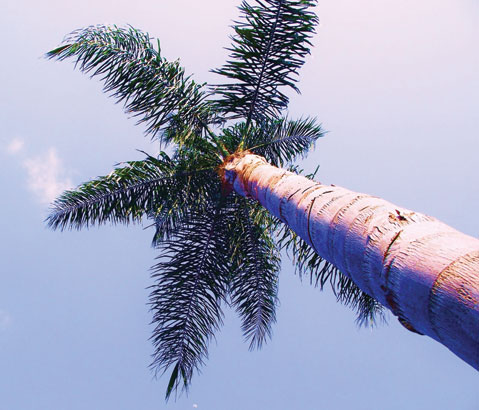Perfect Palms
Kings, Queens, and Pygmies Grow Well in S.B.

Palms lend a tropical air to the landscape because most palms require plenty of water. There are a couple of hardier palms that do well in Southern California’s environment where natural precipitation occurs only half of the year (or less).
The king palm (Archontophoenix cunninhamiana) and the queen palm (Syagrus romanzoffiana) are iconic street trees all over the Santa Barbara area. Native to rain forests of Eastern Australia and Brazil, respectively, they look best with some supplemental watering but can survive once established.
The desert-dwelling palms are no different. They only occur in oases or where river water can be channeled to them. This kind of cultivation has been going on for more than 8,000 years for date palms (Phoenix dactylifera), for example.
Phoenix palms have pinnate (feather-like) leaves that form more or less dense crowns, and the related species that thrive in our cooler coastal climate provide that same iconic oasis look. Although none of them produces edible fruits, they all go by the name date palm. There are three common species in a range of sizes. The most diminutive is Phoenix roebelenii. Called the pygmy date palm, it is native to the humid forests of Laos, Thailand, and Vietnam. It grows rather slowly and may eventually reach 10 feet in height. In cultivation it is most often a solitary palm, but occasionally it occurs as a multistemmed cluster just as it does in the wild. A fairly rare type may also branch above the ground, forming a sort of candelabra shape. Because it can tolerate a fair amount of shade and remains small, it is often used in planters and courtyards.
The stoutest Phoenix is the solitary Canary Island date palm (P. canariensis). As its name suggests, it is native to the Canary Islands. It can reach 75 feet in height on a trunk about 3 feet in diameter. The large crown of pinnate leaves may contain as many as 200 fronds and spread to 40 feet in diameter. Clearly, this palm is not for small gardens, but it is widely planted as a street tree and in parks and public spaces. It has striking orange inflorescences in winter and early spring.
The Senegal date palm (P. reclinata), naturally growing along riverbanks in southern Africa, has clusters of tall slender stems. They grow to 25 feet or more and are only 4-7 inches in diameter. This species continues to send up new shoots, and over the years, the clumps can become quite large. As the stems grow upward, they must arch away from the center, giving the palm its species name, which means reclining.
In the Santa Barbara area, these three species are easy to grow. Once established, the Canary Island date palm can survive without supplemental water. The Senegal and pygmy date palms require regular water (less than a lawn, though) to keep them in good health. In nature, old leaves on the Canary Island date palm may persist for many years, and in most landscape situations, they will be pruned off periodically for a neater appearance. The other species drop their leaves more readily, leaving bumps or scars in a regular pattern. Care should be taken when working on these palms as their lower leaflets are reduced to stiff spines. They can easily puncture skin, so heavy gloves and long sleeves are a must. Protective eyeglasses or goggles are highly recommended.



